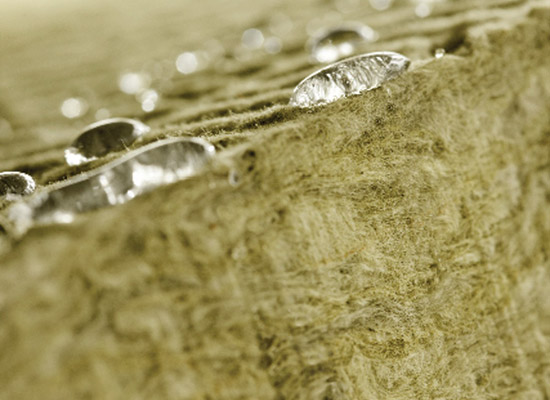Stone Wool Roof Insulation - A Climate Driven Choice
Beyond R-Values: Other Considerations
While the significance of R-value is high, there are also other characteristics to consider when selecting the best insulation for a particular location and climate.
Moisture Content
There is a common misperception that stone wool insulation is moisture sensitive. In reality, stone wool acts as a hydrophobic material and is water repellent yet vapor permeable. This means that the insulation does not absorb or hold moisture so the R-value and other physical properties are not affected by water exposure as with some insulation such as fiberglass. The permeability means that the material is breathable so no double vapor barrier or trapped moisture issues arise. Further, being water-repellent also means that stone wool insulation does not promote rot, corrosion, fungi, mold, or bacterial growth.
One of the special properties of stone wool is the non-directional orientation of the material, making it ideal for repelling and draining water away from the exterior walls, industrial pipe, interior walls, or whatever the insulation is protecting. Similarly, an important benefit of the insulation is its ability to allow trapped vapors in a roof or wall assembly to disperse throughout the insulation layer. Hence, water exposure from leaks in a membrane or from condensation within the assembly can be removed by allowing the insulation to vent this moisture. Stone wool will quickly dry out to become fully restored and retain its original characteristics.
 |
Stone wool insulation board will repel bulk water and disperse water vapor while foam insulation can trap moisture in the assembly. Image courtesy of ROXUL, Inc. |
John Straube, Ph.D., P.Eng., of the Building Science Corporation, has noted from their research: “Stone wool is hydrophobic and water repellent. It sheds water like water off a duck's back because of oils and resins in the stone wool itself so it actually is highly water repellent.” They have further noted, “The normal comparison to stone wool insulation would be some types of foam insulation. If the design is not taking into account the vapor-resistant properties of foam, you can trap moisture in a roof or a wall assembly. And of course, trapped moisture leads to damage such as mold growth, corrosion, or decay.”
In the RDH (Dell/Graham) field study, the researchers found that “water vapor moves within stone wool insulation more readily than polyiso insulation resulting in greater accumulations during periods of high and low temperature. This means that with stone wool insulation there is the potential for more water vapor redistribution with the roof system in the event of a leak.” In other words, the permeability of the insulation allows moisture to move and may help to keep other materials dry. Some further independent testing from the Fraunhofer Institute in Boston shows that stone wool insulation R-values remain stable even with water content up to 3.1 lb/ft3 (50 kg/m3). In all, these findings indicate that stone wool isn't affected by moisture, in fact it helps dissipate it. In the process the R-value of the insulation is maintained while the product remains stable and durable as well.









